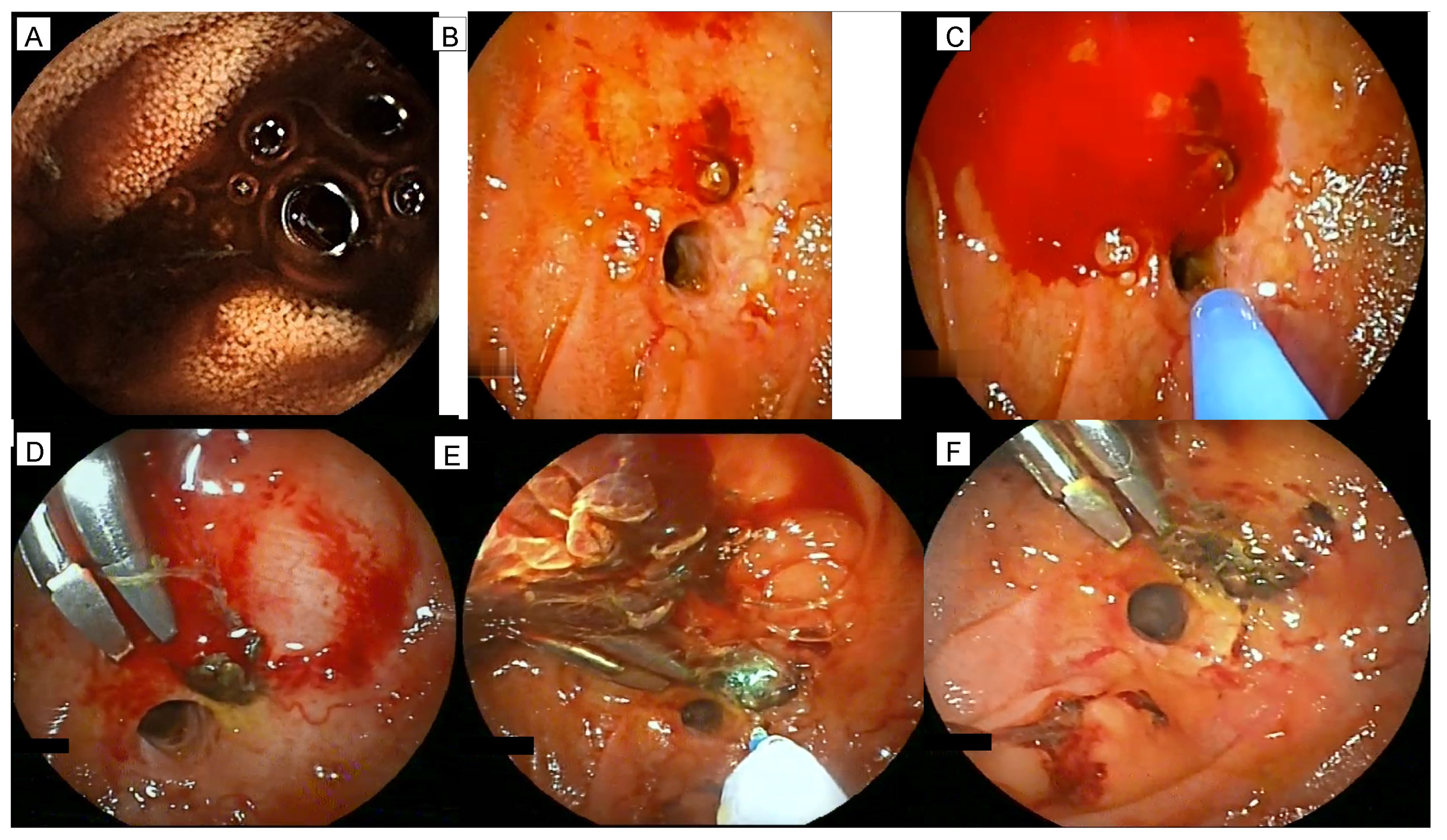Bleeding Lesion from Roux-en-Y Hepaticojejunostomy: A Successful Combined Hemostasis with Dual Emission Laser 1.9/1.5 μm
Abstract
:Supplementary Materials
Author Contributions
Funding
Institutional Review Board Statement
Informed Consent Statement
Conflicts of Interest
References
- Ferretti, F.; Fraquelli, M.; Cantù, P.; Penagini, R.; Casazza, G.; Vecchi, M.; Orlando, S.; Invernizzi, F.; Branchi, F.; Donato, F.M.; et al. Efficacy and safety of device-assisted enteroscopy ERCP in liver transplantation: A systematic review and meta-analysis. Clin. Transplant. 2020, 34, e13864. [Google Scholar] [CrossRef] [PubMed]
- Tontini, G.E.; Rimondi, A.; Scaramella, L.; Topa, M.; Penagini, R.; Vecchi, M.; Elli, L. Dual emission laser treatment and argon plasma coagulation in small bowel vascular lesion ablation: A pilot study. Lasers Med. Sci. 2022; ahead of print. [Google Scholar] [CrossRef]
- Tontini, G.E.; Dioscoridi, L.; Rimondi, A.; Cantù, P.; Cavallaro, F.; Giannetti, A.; Elli, L.; Pastorelli, L.; Pugliese, F.; Mutignani, M.; et al. Safety and efficacy of dual emission endoscopic laser treatment in patients with upper or lower gastrointestinal vascular lesions causing chronic anemia: Results from the first multicenter cohort study. Endosc. Int. Open 2022, 10, E386–E393. [Google Scholar] [CrossRef] [PubMed]

Publisher’s Note: MDPI stays neutral with regard to jurisdictional claims in published maps and institutional affiliations. |
© 2022 by the authors. Licensee MDPI, Basel, Switzerland. This article is an open access article distributed under the terms and conditions of the Creative Commons Attribution (CC BY) license (https://creativecommons.org/licenses/by/4.0/).
Share and Cite
Marinoni, B.; Elli, L.; Tontini, G.E.; Scaramella, L.; Penagini, R.; Vecchi, M.; Nandi, N. Bleeding Lesion from Roux-en-Y Hepaticojejunostomy: A Successful Combined Hemostasis with Dual Emission Laser 1.9/1.5 μm. Diagnostics 2022, 12, 2107. https://doi.org/10.3390/diagnostics12092107
Marinoni B, Elli L, Tontini GE, Scaramella L, Penagini R, Vecchi M, Nandi N. Bleeding Lesion from Roux-en-Y Hepaticojejunostomy: A Successful Combined Hemostasis with Dual Emission Laser 1.9/1.5 μm. Diagnostics. 2022; 12(9):2107. https://doi.org/10.3390/diagnostics12092107
Chicago/Turabian StyleMarinoni, Beatrice, Luca Elli, Gian Eugenio Tontini, Lucia Scaramella, Roberto Penagini, Maurizio Vecchi, and Nicoletta Nandi. 2022. "Bleeding Lesion from Roux-en-Y Hepaticojejunostomy: A Successful Combined Hemostasis with Dual Emission Laser 1.9/1.5 μm" Diagnostics 12, no. 9: 2107. https://doi.org/10.3390/diagnostics12092107
APA StyleMarinoni, B., Elli, L., Tontini, G. E., Scaramella, L., Penagini, R., Vecchi, M., & Nandi, N. (2022). Bleeding Lesion from Roux-en-Y Hepaticojejunostomy: A Successful Combined Hemostasis with Dual Emission Laser 1.9/1.5 μm. Diagnostics, 12(9), 2107. https://doi.org/10.3390/diagnostics12092107





